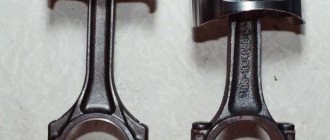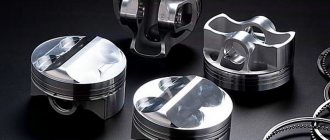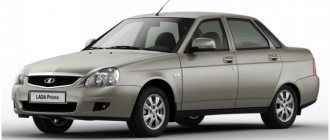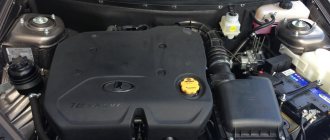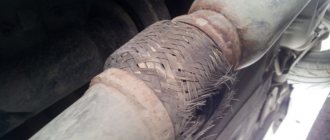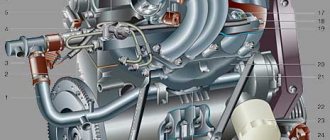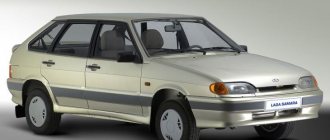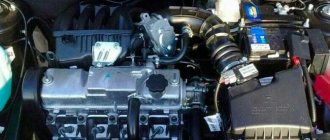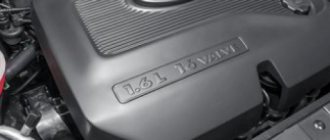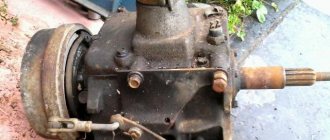Owners of Lada Priora cars often find themselves in unpleasant situations. A broken timing belt leads to dire consequences. The thing is that the pistons that the manufacturer installs at the factory when assembling the engine have recesses of insufficient depth. Motorists call these selections counters. This is the cause of destruction. Repairing the engine after such an incident will be expensive for the car owner. It is cheaper to replace the standard ones with the so-called plugless pistons on the Priora.
Physics of pistons, loads
This element is designed to convert energy from a fuel explosion into translational motion and transfer it to the crankshaft. When gases expand after an explosion, mechanical and temperature effects are exerted on the piston and its working surface. The part experiences high-intensity loads. The maximum possible pressure in the Priora engine can reach up to 65-80 bar. This is practically several tons.
During operation, the pistons can periodically accelerate their movements to 100 km/h or more. Also, their movement can slow down to almost zero at a frequency of up to 200 Hz at 6000 rpm. When a mixture of fuel and air explodes in a cylinder, the temperature inside can reach 1800-2600 degrees. Under such temperature influences, the strength characteristics are reduced. Thermal stresses arise due to sudden temperature changes. It is also worth adding stress from the pressure of combustion products and inertia during acceleration and deceleration at high frequencies.
Pistons, pins, rings for Lada Granta (VAZ 2190, 2191) | Motorring online store
Product groups
- Freebie!
- New items
- Appearance
- Salon
- Engine
- Exhaust system
- Intake system
- Steering
- Transmission
- Suspension
- Brake system
- Fuel system
- Electrical and electronics
- Climate system and ventilation
- Alarms and anti-theft systems
- Windshield wiper and accessories
- Car accessories
- Special tools Roller cutters, countersinks, cutters, countersinks
- Cutting tool
- Those. engine maintenance and repair
- Chassis repair and maintenance
- Fuel pump pullers
- Special auto tools
- Special tools "AvtoDelo"
- Flaringers, pipe cutters, pipe benders
- Crescent keys
- Glass repair
- CV Clamp Pullers
- Steering rod and ball joint pullers
- Measuring instruments and tools
- Torque wrenches
- Tire inflation guns
- Mini ratchets
- Car jacks
- Spray guns
- Tools miscellaneous
- Technical hair dryers
- Tool sets
- Body work
- Stripping wires, crimping terminals
- Extractors, Nut Cutters, Hairpin Drivers
- Oil filter pullers
- Universal pullers
- Oilers, plunger syringes
- Impact and reinforced screwdrivers
- Hub pullers and wrenches
- Ties, cables
- Milling cutters for cylinder head modification
- Honing the cylinder
- Working with interior trim
- Retaining Ring Pullers
- Metal brushes
- Lada Granta
- Tuning for hunting and fishing
Shipping reports We accept
The group contains 68 / 68 positions
by popularity
by price
Purpose, device, malfunctions
Fuel savings and tighter emissions regulations are spurring engine manufacturers to take a fresh look at the car's main driving force: the piston. New piston designs with reduced weight, improved strength, and durability are being developed and introduced. Until recently, the piston remained a relatively low-tech component. Now, with the help of computer simulation analysis, piston manufacturers are developing and tuning pistons for specific engines, creating new designs in record time.
The piston withstands large explosive loads by transmitting reciprocating motion through the connecting rod and crankshaft to the wheels. Piston strength is one of its key characteristics, remaining unchanged in difficult racing conditions or tens of thousands of kilometers on the track. Whatever the engine - V6 or V8, turbocharged or diesel - the piston must withstand the load and ignition temperature of the air-fuel mixture. This, in turn, depends on the composition of the alloys from which the piston is made. Yesterday's cast iron pistons can no longer compete with their new high-tech counterparts.
Forged pistons have been around since the 1950s, when they were used as pistons in many engines during the heyday of automotive manufacturing. Today, forged pistons dominate professional racing. They are also widely used in aircraft, marine, heavy truck, diesel and agricultural engines due to their high reliability. Conventional cast pistons are made by pouring molten aluminum into a specific mold. The cooled metal is machined to the required size.
Most cast pistons undergo a heat treatment, which involves heating (a process called "aging") to relieve stress in the metal. Piston design today is not as simple as it once was. Increasing the amount of fuel supplied to the cylinder requires changing the shape of the piston top cup. Modern pistons are designed as special piston configurations with a unique dome shape to optimize the combustion process, and have recesses at the top to swirl the fuel mixture and direct it towards the spark plug, inducing a vortex when the piston is on the compression stroke.
Other manufacturers create a recessed cavity directly under the spark plug to concentrate the fuel mixture and speed up the combustion of the unburnt fuel, exposing it to greater temperatures, reducing the risk of detonation. All parts of the design can be changed, affecting the compression ratio, the size of the holes, piston rings and piston pin, up to changing the piston height and skirt length. A short piston skirt means less weight. Another way to reduce weight is to reduce the compression height.
About the design of standard pistons
In order to work in such conditions, the part must be as light as possible. And the material is wear-resistant. The alloy must also have high thermal conductivity. This will ensure a high cooling rate. External working surfaces must be made in such a way that the part does not jam in the heated cylinder. Also, combustion products should not penetrate the crankcase. The piston is barrel-shaped; there is a big difference between the degree of heating of its working part and the skirt. This allows all requirements to be met.
To compensate for possible deformations of the skirt during operation, the piston is manufactured with a “counter-ellipse”. The major axis of the part is strictly perpendicular to the axis of the hole for installing the pin.
The piston head or its upper part includes the bottom. There are also special grooves for mounting o-rings. To ensure that the upper part can cope with high loads, it is covered with a special layer of protective coating at the production stage. The grooves for installing the rings are made so that there is a slight angle. This ensures that the outer edge of the ring is located higher than the inner one. This prevents the cross-section of the groove from tilting downwards during operation at high temperature loads. To ensure better sliding, the piston is treated with special coatings over the entire working surface. In order for the part to run in better, coatings are applied that will wear out during the running-in process. This is tin coating or phosphating. Materials that improve slip remain on the surface throughout the entire service life.
The skirt is processed using cutters. This is done to obtain a microrelief. Due to this, the oil is better retained on the surface of the part, thereby reducing friction.
VAZ engines – “non-stick” and “risky”
Since several power plants are installed on each of the VAZ models, it is important to know which of them are “plug-in”. As already noted, on the classic VAZ (2101-2107) and VAZ Niva, power units were installed in which the valves bend
But since the timing drive on these engines is a chain drive, “butt-in” can not be taken into account
As already noted, the classic VAZ (2101-2107) and VAZ Niva were equipped with power units in which the valves bend. But since the timing drive on these engines is a chain drive, “stick-in” can not be taken into account.
"Samara"
The following were installed on cars of the Samara family (VAZ 2108-21099):
- Units marked VAZ 21081, 2108 (carburetor and injection);
- Motors 21083, 21091;
- 8-valve VAZ-2111 (models of later years of production).
Of these, units 21083 and 2111 did not bend the valves when the timing belt broke, but versions 21081 and 2108 were “risky”.
VAZ 2110-2112
On models of the 10th family (VAZ-2110-2112), the range of power plants is even more extensive. Some units were installed on all cars of this family, while some were offered only for certain models.
Common to all models were engines with the indexes VAZ-2110, 2111 (8-valve), 2112, 21114, 21124. Of these, the VAZ-2112 and 21114 engines are “plug-in”, and the remaining valves do not bend.
Additionally, the VAZ-2112 model car was equipped with a VAZ-21128 power unit, which is also “risky” and bends the valves when the timing belt breaks.
"Samara-2"
Cars of the Samara-2 family, which includes the VAZ 2113-2115 models, are equipped with units of the VAZ-2111, 21114, 21124 and 21126 brands. Of these, only VAZ-2111 and 21124 engines are “risk-free”.
Also for the VAZ-2113 and 2115 versions, a motor with index 11183 was offered, in which a broken belt does not lead to bending of the valves.
"Granta", "Kalina", "Priora"
The Lada Granta is equipped with a line of units of the following brands: 11183, 11186, 21126 and 21128. The last two of them are also equipped with the Granta Sport version. Of all the engines, only version 11183 is “non-plug-in”, the rest have bent valves.
For the Lada Kalina, engines of the VAZ brands 11183, 11186, 11194, 21126 and 21127 are offered. The last two units are also installed on the Kalina Sport model, and the Cross version is equipped with engines 21127 and 11186. Of the entire line, only the VAZ-11183 engine does not bend valves when the timing belt breaks.
Lada Priora is equipped with units with indexes 21114, 21116, 21126 and 21127. All these engines are plug-in.
Please note that only the main brands of power plants that are equipped with certain models are listed above. But AvtoVAZ almost always “sins” with experimental small-scale production, when units that are uncharacteristic for it are installed on some cars.
For example, the VAZ-2109 was equipped with an engine with an identical index, which differed from the 2108 version in a lightweight design, and the small VAZ-2108 series was even equipped with a rotary unit labeled VAZ-415.
READ ON THE TOPIC: Other characteristic malfunctions of the VAZ 2110 and other models of the series.
Differences in the design of “safe” pistons for Priora
So, the plugless pistons on the Priora are practically no different from the standard ones. This is actually an exact copy of a standard piston for AvtoVAZ engines.
But there is no traditional mirror on the top - instead there are deep recesses. This allows you to protect both the timing parts and the pistons themselves when meeting the valves. Dimensions and all other parameters fully correspond to the characteristics of standard parts.
Groove on top
To call them plug-free is not literary, but in a “garage” way - they will immediately understand you and appreciate your technical potential! This name comes from a simple trick - the piston does not meet the valve with the help of a special groove on top - that is, the valve DOESN'T fit into the piston, that's the name.
However, if you tell it technically and literary correctly, it turns out that there are several grooves in the upper part of the piston. Their number can be different - from 2 to 4 pieces. It is thanks to these grooves that these two engine elements do not meet. That is, the correct name is a piston with grooves.
Why install non-factory pistons?
This is different for each car. If you fully comply with the manufacturer's regulations for engine maintenance, install recommended or at least high-quality spare parts and consumables, then the car will serve for a long time and properly, and all mechanisms and components will operate in their normal modes.
But everyone wants to save money or have their car tuned, and here a number of questions arise. If you save at the expense of the timing belt (and this is the belt and rollers for it), buying obviously low-quality parts, then you should take into account that their replacement intervals will drop as well as the price. For example, if as a standard on AvtoVAZ engines the belt should be changed after 30-50 thousand km, then rarely anyone managed to drive more than 5-10 thousand km with cheap and non-original components.
Some tuning specialists try to take everything and even more from the engine than it can give. Motors are often equipped with compressors. However, most of the parts and components in the engine are not at all designed for such loads. The engine cannot operate for a long time in the range of 7-9 thousand revolutions. The timing mechanism is not designed for such use either - the weakest link is always damaged. And this is the belt. And what to do when you want to save money and still not drive slowly? You can get out of this situation by installing plugless pistons on the Priora.
pros
Needless to say, this system is very durable. Even if your timing belt breaks and the overhead camshaft with a set of valves freezes in place. If the piston comes from below, pushed by the crankshaft, then no disaster will happen - they will simply fall into the grooves and everything will be fine. That is, we just take the car to the service station, they restore the timing mechanism and you drive on. A VERY big plus.
I would like to note right away that if there are no such grooves, then you are faced with a very unpleasant repair. You can change the pistons, and the camshaft pastel; I’m already silent about the timing belt with all that it implies. Repairs, for example, on a foreign car of class “C” or “D” can vary from 30,000 rubles and more! That’s why many people think about installing “stickless” pistons; they sleep more peacefully - well, the system breaks down, so what, the grooves will save them.
But if you think about the disadvantages, they also exist and for many manufacturers they are significant!
Flaws
In the process of creating various AvtoVAZ engines for front-wheel drive models, designers and engineers initially created similar pistons. Priora already had plug-free grooves from the factory (in early versions). More often they can be found on VAZ engines of the tenth family. This was due to the use of a belt instead of a chain. If you lighten the piston as much as possible, the engine gains an additional 5-7 percent of power, which is a lot. Replacing the pistons on the Priora with plugless ones will not increase power. This will only protect you from expensive repairs. To make a groove, the surface must be thick enough. The piston is made heavy, which takes away power. The groove also has an unsatisfactory effect on the compression of the combustible mixture. This also affects power. As a result, if you install such parts on a car, the engine loses 5-7% of its power. For a 150 hp engine. With. this is 10.5 l. s, which is very significant.
This is what those who have already installed plugless pistons on their Priora car write. Reviews show that, in addition to a decrease in power, fuel consumption has increased. Detonation increases due to uneven weight distribution.
Price issue
As for the cost of work, the spread here is very large. In the Moscow region, depending on the service, repairing such a VAZ engine will cost from 15,000 to 40,000 rubles.
To “bring to mind” the VAZ-21116 engine, you will have to spend time searching for spare parts and a decent amount of money. But if the plug-in engine has already failed - and this can happen to it anytime, anywhere - such a modification is guaranteed to save you from repeating a similar situation and all possible consequences.
Send all questions and suggestions regarding the “Technical Environment” series of issues to
Other episodes of “Technical Environment” are available in our special project, as well as on our YouTube channel.
Source
STI, Tolyatti
These products are manufactured in Tolyatti using hot pressing technology. Judging by the reviews of those who have already equipped the engine with them, the parts significantly reduce the efficiency and power of the engine. This can be explained by the low compression ratio and large cylinder size. Valve recesses are too deep.
The low silicon content in the alloy does not have the best effect on the strength characteristics. A lower nickel content reduces the resource. At the same time, forged pistons from STI have a high cost.
Domestic 16-valve engines
A little preface. When faced with 16-valve VAZs at the household level, remember that such cars are always equipped with 14-inch wheels, since there are enlarged ventilated brake discs at the front.
So, the “gear” came from an 8-valve engine. In the articles you can find mentions that VAZ wanted to create a powerful and economical engine, and so, the “gear” will never be more economical than an eight-valve engine. Consumption 16 cl. engine 7.5 - 10 liters, depending on the dynamics.
The first engine from the line was 21120 (hereinafter referred to as the 120th
). The volume is one and a half liters, equipped with an ignition module, the valves bend. Visually different is the cast intake manifold. It was developed for cars 2110-2112, installed in various modifications such as “Premier” and 2112 in a two-door hatchback body. It went into production in 1996 and was installed on cars until 2004. If today you buy a car with such an engine, then most likely it has already undergone repairs and a “plug-in” piston is installed on it.
In 2004, the 120th engine was replaced by a new one with the index 21124 (hereinafter referred to as the 124th
). In addition to cars of the tenth family, it was installed on the VAZ 2113 and VAZ 2114.
This engine does not bend the valves, thanks to grooves on the pistons, this is its main difference from its predecessor. It is easy to distinguish by its plastic intake manifold. In addition, the ignition module has been replaced with individual coils for each cylinder. Engine capacity increased to 1.6 liters.
Many people call this engine the most balanced in the VAZ line, and I think this is true. Its service life is at least 200 thousand, if you drive “without fanaticism”.
In 2007, the tenth family left the assembly line (the vehicle kits were sent to Ukrainian as punishment) and the Priora was released. This “breakthrough” in mechanical engineering was equipped with the 21126 engine ( 126th
). It was equipped with lightweight connecting rods, pistons, liners, and other parts, which made its service life less than that of a 124 engine. In order to increase power, the grooves on the pistons have been removed and the valves on this engine are bent.
21128 or 128th
the motor was created and installed on Priora and 2110-2112, which were produced by this company. This is the heir to the 124th engine, the engine capacity has been increased to 1.8 liters, which has a negative impact on the service life. In practice, I saw one such car, which, with a mileage of 90 thousand kilometers, suffered from severe oil consumption. This engine received a lot of negative reviews.
In 2013, 21127 appeared or 127
-th engine, its power was increased to 106 horsepower, an adjustable air intake through the receiver was installed, the mass air flow sensor was abandoned in favor of the DBP (absolute pressure sensor) and the DTV (air temperature sensor). The valves in this engine are bent.
And the last creation we will look at is this 11194
engine. It has a volume of 1.4 liters, installed on Kalina. At one time I drove such a Kalina, and the meaning of such an engine is not clear to me; it drives exactly the same as an 8-valve one. The reviews leave much to be desired, and for its unjustified oil consumption, the engine was nicknamed the “legendary Kalinomotor”, of course, not without sarcasm.
We briefly looked at the "six" from VAZ. In this article I will not touch on modern Vest engines and other creations of AVTOVAZ; to be honest, I’m losing interest in studying the crafts of the alliance of the French and Japanese.
If the article was interesting, then give it a thumbs up and subscribe to the channel.
Source
Subtleties of ShPG
Let's move on to the most interesting part - the connecting rod and piston group. On our plug-in engine, the pistons do not have grooves for the valves. We decided to replace the pistons with new ones, with grooves, and together with the connecting rods, since the old ones were bent. We ordered spare parts from the official dealer Federal Mogul. The kit for one cylinder includes a piston, rings, a pin and the connecting rod itself, along with bolts for securing the lower cover of its head. Grooves are visible on the bottom of the pistons, as well as the number 11189, an arrow indicating the direction of installation of the piston in the cylinder block, and the production date. The skirt has an improved iron oxide coating to protect it from damage.
The lower head of the connecting rod is made using breaking technology, due to which the joint is practically invisible. The bolts that secure the bottom cover of the connecting rod are tightened in two steps: first with a torque of 20 Nm, then turned by 135°. Protrusions on the bottom cover and on the connecting rod body help you navigate during assembly. On the bottom head of this spare part, on both sides, there is a marking duplicated in two places: the release date of the part and its batch number are indicated. All numbers must match.
Based on the diameter of the skirt, pistons are divided into three classes. We had class B pistons, so the new ones have the same class, as indicated by the corresponding markings on the parts. There is also a mark on the cylinder block - on the mating surface, next to the threaded holes where the engine sump is attached.
When purchasing spare parts, it is also important to consider the connecting rod weight class! This information is on the cover of its lower head. There are three such classes, and they are indicated by dots - one, two or three
The set must contain connecting rods of the same class or neighboring ones, for example, first and second, but in no case first and third.
After installing the piston group and tightening the connecting rod bolts, we install the aluminum pan. There is no need for a gasket here - just sealant. It is advisable to use an oil and petrol resistant composition. Only a small amount of sealant should be applied so that excess is not squeezed into the internal cavity.
What is a “plug-in engine”?
This concept characterizes the likelihood of a collision between pistons and valves, as a result of which the latter are damaged - they bend.
This situation occurs when the timing drive breaks, when the gas distribution mechanism stops, but the crank continues to work by inertia.
“Plug-in” and “non-plug-in” power units are available in the lineup of almost all automakers, including VAZ. At the same time, the second engine option, naturally, is a higher priority when choosing a car.
If we consider AvtoVAZ products, then this manufacturer’s line of power plants is quite extensive, and in some engines, when the timing drive breaks, the valve bends, while in others such a breakdown does not occur.
The problem when choosing to purchase a VAZ car is the fact that the same model can be equipped with both “plug-in” and “non-plug-in” units, which can confuse the buyer.
See below for which engines are installed on some VAZ models.
It is worth noting that the type of timing drive affects the likelihood of valve bending. For example, on the VAZ of the classic family (VAZ-2101-2107) and also the Niva, only plug-in engines were installed. But the engines of these cars use a timing chain drive, which is highly reliable. Therefore, on classic VAZ and Niva, the problem of valve bending due to a collision with the piston is, in fact, not relevant due to the low probability of its occurrence.
Starting from the VAZ-2108 and ending with the latest models - Priora, Granta, Kalina, etc., only a timing belt drive is used. So it can break off and the damage that the motor receives depends on whether it is “plug-in” or not.
Decoding of the index in the name of the AvtoVAZ engine
At first, the internal combustion engine index was tied to the car model on which it first appeared.
Now the concern has formed a unique system for naming its units:
First two digits
11 or 21 means the number of the workshop where their assembly was established
Third digit
here it acts as a separator and for now it is always equal to one
Fourth digit
indicates the number of valves: 1 and 8 are 8v, and 2, 7 and 9 are 16v
Fifth digit
reports the position of the internal combustion engine in the series and the larger it is, the newer the engine
You can contact the site administrator by email:
All texts were written by me, are authored by Google, included in the original Yandex texts and notarized. For any borrowing, we immediately write an official letter on company letterhead in support of search networks, your hosting and domain registrar.
Next we go to court. Don’t try your luck, we have more than thirty successful Internet projects and have already won a dozen lawsuits.
Source
FakeHeader
Comments 96
Good day, almost two years have passed since you wrote this post, tell me what is your opinion now about STK pistons, what is the current mileage, has there been any knocking or oil consumption?
Thanks everyone, bought everything, changed it, started it))) report later STK piston pins rings prima liners
What group did you put in?
Thanks everyone, bought everything, changed it, started it))) report later STK piston pins rings prima liners
Our weather is great, the roads are great too, it’s just a matter of driving it around.
STK take it - just don’t smell the automatic machine! - www.drive2.ru/l/5810979/ on the rollers of the belt - these are reinforced - - Timing belt - CONTITECH - CT1137 - Reinforced double-row support roller - TORQUE - KR5071 - Reinforced tension roller - TORQUE - KR5070
Thanks, I took the stk
STK take it - just don’t smell the automatic machine! - www.drive2.ru/l/5810979/ on the rollers of the belt - these are reinforced - - Timing belt - CONTITECH - CT1137 - Reinforced double-row support roller - TORQUE - KR5071 - Reinforced tension roller - TORQUE - KR5070
I installed the Torque rollers, they started buzzing right away from the box, I went to change them...
I personally installed it on 20 cars at my service center - not a single one buzzed - I really liked it
Well, apparently I got such a kit
change the key on the crankshaft along with the gear and belt, I will recommend ContiTech, the quality is excellent) good luck with the assembly
install the stk piston male rings only take the rings measure on the piston otherwise they gave me the VAZ ones of the required group and they didn’t fit took the male ones and don’t listen to about putting the belt on and drive I bought the car already had a Gates original belt, I checked it myself from the roller only 4000 bypass pulley fell apart thanks to the yellow-throated brothers (by the way, they told me that a Toyota roller can be picked up) and my stsuka was already torn, and at idle 14 valves out of 16 were bent; in total, I spent 18 rubles on spare parts for the piston head and everything else, so it’s better to change it than to spend it later, now I’m running in the piston stk drove 1000 km so far everything is fine oil is in place more than 2500 I don’t let you drive like a fart patience is running out :)
Subtleties of ShPG
Let's move on to the most interesting part - the connecting rod and piston group. On our plug-in engine, the pistons do not have grooves for the valves. We decided to replace the pistons with new ones, with grooves, and together with the connecting rods, since the old ones were bent. We ordered spare parts from the official dealer Federal Mogul. The kit for one cylinder includes a piston, rings, a pin and the connecting rod itself, along with bolts for securing the lower cover of its head. Grooves are visible on the bottom of the pistons, as well as the number 11189, an arrow indicating the direction of installation of the piston in the cylinder block, and the production date. The skirt has an improved iron oxide coating to protect it from damage.
